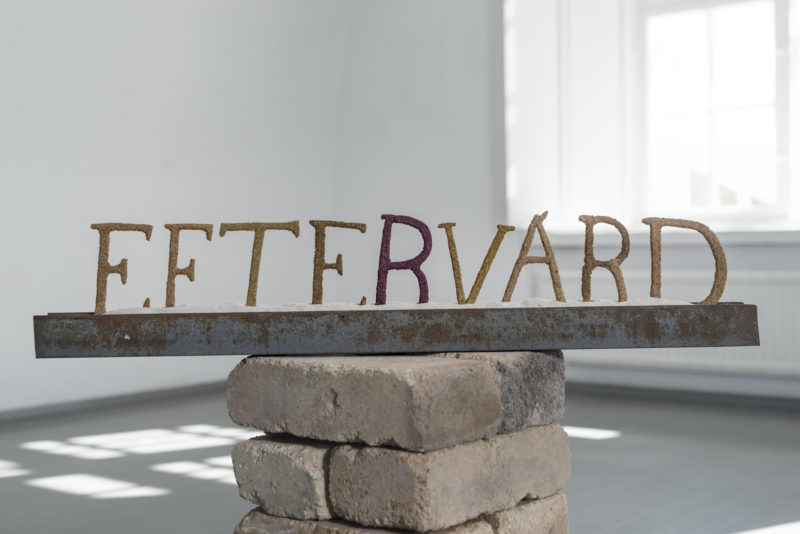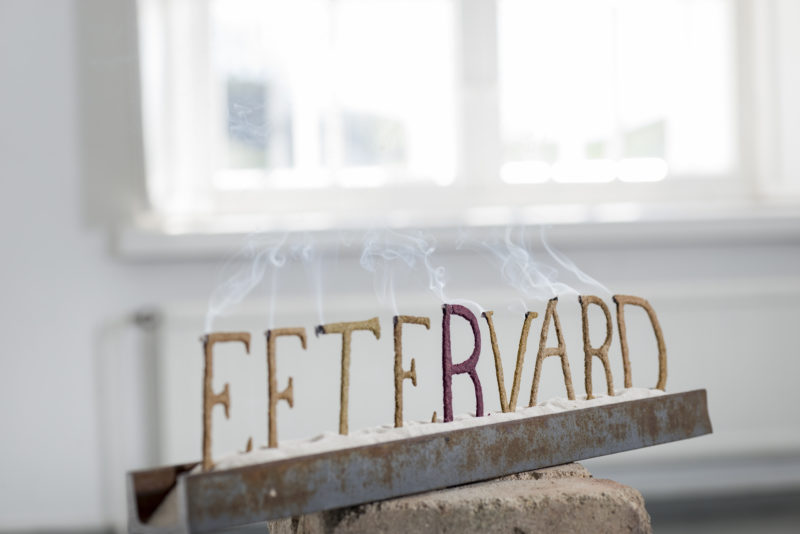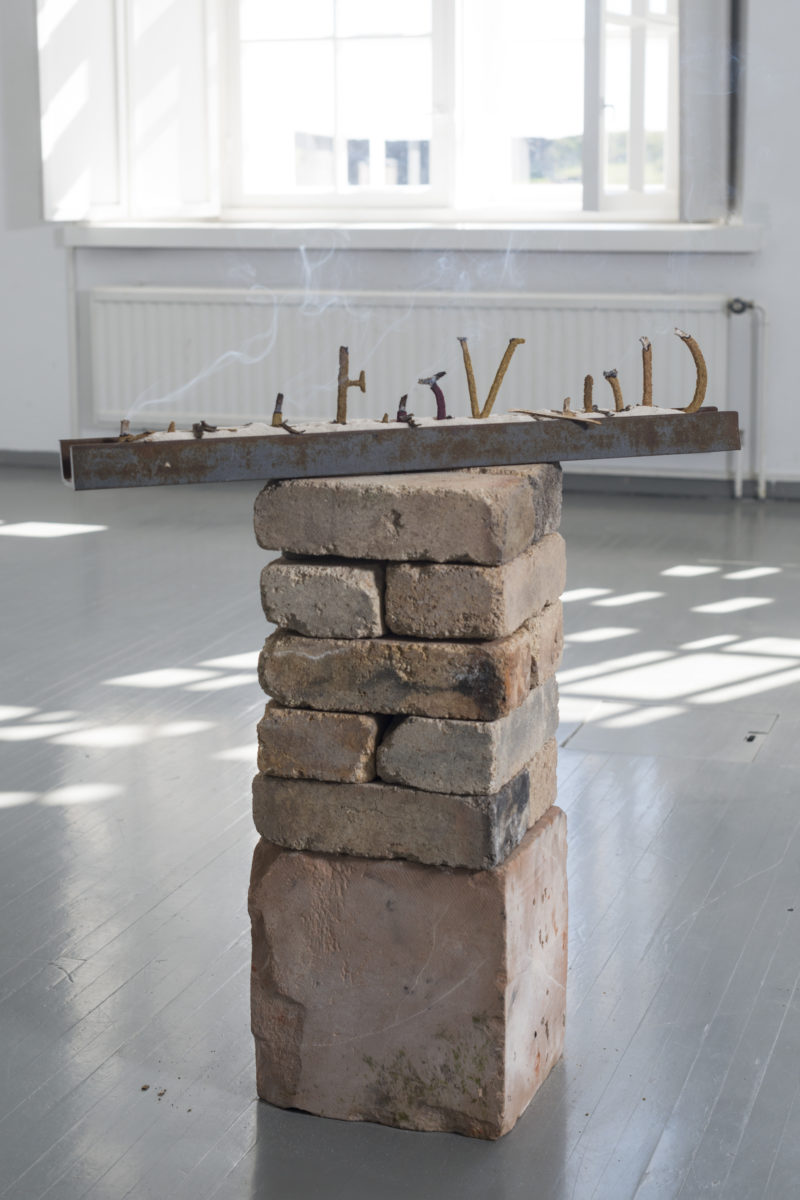19 Oct 2020
News
Afterthoughts on ‘Eftervärd’, the smouldering incense installation by Elina Vainio

In the final days of the COVID-19 lockdown in Finland, I got to experience an ephemeral artwork under very special circumstances. By the invitation of HIAP and the artist Elina Vainio, I participated in the private burn event of ‘Eftervärd’, Elina’s new incense-based sculptural installation. The event, which was held on the Suomenlinna island off the coast of Helsinki and attended by just the artist and myself, left me in awe and longing for more encounters as intimate as this with contemporary art.
Experiencing the work started as soon as Elina and I hopped onto the ferry. Swayed by the gentle waves of the Baltic Sea, we discussed the process of making this piece that emerged both in response to the intertwined botanical and human histories of Suomenlinna fortress island as well as the unnerving unfurling of the present.
In the spring months, Elina had a studio on the island as part of HIAP’s residency programme. Whenever she could come to work there, she would embark on long, meandering walks. These were for her a method of attuning to the environment and its seasonal changes. Her attention was captured by the architectural features of the sea fortress as well as its plant life, and she learned how both of these tell volumes about shifting political dynamics over the nearly four centuries of its existence. Suomenlinna’s sturdy rock fortifications were built with the local stone by the Swedes in the 18th century. Most of the red brick buildings were constructed by the Russians in the 19th century – and both Swedish and Russian occupants brought along a variety of plants. Vegetation arrived at this previously barren place from other corners of the world as well. The myriad international influences and migration paths are still present in the rich botanical life of the islands, which differs significantly from the flora of the neighbouring islands and the mainland.

The island’s human inhabitants made their marks in stone: The carved plates at the King’s Gate especially caught Elina’s eye. It was here that the foundational stone of the fortress was laid. The word ‘Eftervärd’, old Swedish referring to the afterlife, begins a message for the generations yet to come: Stand your ground. For Elina, whose oeuvre is marked by curiosity towards the plurality of meanings and the continuous evolution of language, ‘eftervärd’ alludes to the traces of the past alive in the present. She began to ponder how the human and botanical histories of the island are entangled and how the plants are, in many ways, a living form of an afterlife of the island’s human habitation.
As the spring progressed, with the Suomenlinna chief gardener’s permission, Elina started to gather various plants during her walks. Her intention was to dry them and grind them into powders she would use to form incense sculptures. Her inspiration for working with incense traces back to the workshop led by Dambi Kim, the Seoulite tea and incense artist, which I curated for the Fiskars Village Art and Design Biennale in 2019. In the session, Dambi explained the various uses of this beautiful tradition and taught the participants how to use different types of plants to make our own incense sticks and cones. After the workshop, Elina started to learn more about incense-making and burning. She didn’t settle with the more traditional stick and cone shapes, but decided to use the King’s Gate’s ‘Eftervärd’ carving as a mould to make letter-shaped forms.
Coming up with beautifully burning incense letters involved trial and error – the most attractive violet plants, for instance, turned out to be poisonous and not suited for safe burning. After some incidents involving improvised use of an unexpected binding agent, when the time came for the first burn of the work at HIAP Open Studios, ‘Eftervärd’ smouldered as intended, filling the gallery space with its subtle aromas. The site, a former prison – and probably one of the worst places to find oneself in the aftermath of the Finnish Civil War (1918) – definitely benefits from a thorough smudging. The building was my workplace for many years, and so I am all too familiar with the unsettling stories and the strange occurrences associated with it.
 The first burn, attended by some dozen people and beautifully documented on video in complete silence, happened a few days before it was my turn. As Elina and I reached the gallery and entered the exhibition hall flooded with natural light, I could still sense the subtle fragrances and soothing new energy lingering in the space. Using tiles found from the nearby tunnels, Elina had constructed a perfectly balanced foundation for the incense. The letters that still remained were standing in a rusted metal chute filled with fine sand and ash from the previously burned letters. As we came closer, we became quieter and I sat down on the floor as Elina lit up the letters.
The first burn, attended by some dozen people and beautifully documented on video in complete silence, happened a few days before it was my turn. As Elina and I reached the gallery and entered the exhibition hall flooded with natural light, I could still sense the subtle fragrances and soothing new energy lingering in the space. Using tiles found from the nearby tunnels, Elina had constructed a perfectly balanced foundation for the incense. The letters that still remained were standing in a rusted metal chute filled with fine sand and ash from the previously burned letters. As we came closer, we became quieter and I sat down on the floor as Elina lit up the letters.
I was mesmerized by the letters turning into the finest swirls of smoke. They reached for the ceiling before slowly dissolving into the light. Their subtle scents mixed harmoniously with woody and fresh notes. There was something extremely fragile, tender, and caring about this small ritual. All of a sudden, I caught my thoughts whirling around something heavy and hard. A tightness in my chest hinted that I was perhaps being offered a moment for mourning, purification and healing – something that I hadn’t really allowed myself, or even realised I needed, during the past three months spent in physical isolation. This also felt to me like a shared ritual for Elina and myself to renew and reinforce the friendship that began in Suomenlinna in the summer of 2014 and has taken us to work together as far as at the Mugaksa temple in Gwangju in 2018.
After about half an hour of meditative appreciation of Elina’s artwork, and silent reflection of the array of emotions it evoked in me, the incense had burned and it was time to dismantle the installation. Elina explained to me where she had gathered its different parts and where they would eventually be returned. The cyclical thinking, ephemerality, and the careful combining of preciseness with chance, that all characterize her artistic thinking are something that I am very deeply drawn to. As strongly as I desire to experience this kind of one on one ritual again, I wish that that next iteration of this work, planned for October, can be enjoyed by many.
– – – – –
Elina’s new work, the installation Clear, Fair and Certain is on display as part of The Post-Fossil Show at HIAP Galleria Augusta now until November 1st.
Her incense-based installation includes three active burnings. The first took place at the opening of The Post-Fossil Show. The second will take place on 24.10 at 15:30. the third will take place 31.10 at 16:00, to witness the third burning you can sign up here.
